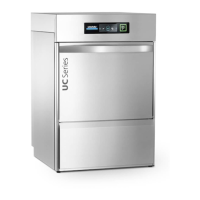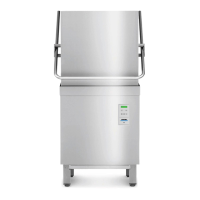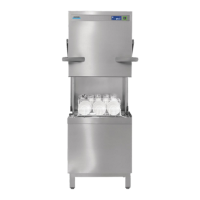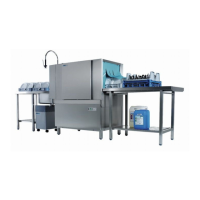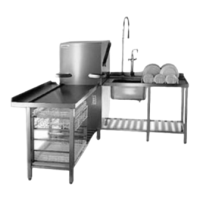



Do you have a question about the Winterhalter UC-L and is the answer not in the manual?
Manual is a component of the warewasher and must be stored accessibly for the user.
Operating instructions are protected by copyright; infringements may lead to damages.
Warewasher is intended for washing gastronomic dishes, cutlery, glasses, pots, trays, and GN containers.
Lists prohibited items and actions such as washing without a rack or with wood parts.
Explains instruction symbols and the layout of warning notices with signal words.
Operator must ensure safe use, provide user info, and arrange for authorised connections and training.
User must adhere to safety regulations, follow responsibilities, read instructions, and work safely.
Details required qualifications and training for personnel involved in installation, operation, and maintenance.
Warns about risks like slipping, cutting injuries, and tipping over. Advises on non-slip footwear and gloves.
Highlights risks of electric shock, emphasizing qualified personnel, proper connections, and safety measures.
Warns about burns from hot components. Advises cooling down, wearing protective gear, and avoiding operation below 0°C.
Warns about severe burns, eye damage, and poisoning from chemicals. Advises protective gear and proper handling.
Stipulates that only trained technicians and original spare parts should be used for maintenance and repairs.
Explains the warewasher's automatic operation: filling, heating, washing, draining, and rinsing.
Provides a labelled diagram showing the main components and features of the UC Series warewasher.
Describes the optional Energy module, which uses a heat exchanger to recover energy from exhaust air.
Details the optional Cool feature for changing rinse temperature, allowing faster use of washed items.
Explains the optional integral water softener that prevents limescale buildup using regeneration salt.
Describes the Excellence-i(Plus) feature with reverse osmosis for limescale-free water and improved wash results.
Provides information on the PAY PER WASH option and directs users to the homepage for details.
Provides information on the CONNECTED WASH option and directs users to the homepage for details.
Explains the operation and features of the warewasher's display, similar to a smartphone interface.
Details different washing programmes available, adapted to various types of ware and soiling.
Describes additional programmes like Intensive, Silence, ECO, Short, and Soaking programmes.
Details special programmes such as Basic cleaning and Descaling programmes.
Explains optional programmes like Reverse osmosis and wash modes such as A0-30 and A0-60.
Describes the Info menu, showing machine status, settings, and contact information for service and suppliers.
Provides guidance on using Winterhalter chemicals, specifically rinse aid and detergent.
Explains the function and identification of suction tubes for rinse aid and detergent with level control.
Lists detailed technical specifications for different UC Series models, including dimensions, capacity, and operating conditions.
Outlines the menus accessible to dishwashing staff, including Error log, Priming, Videos, Addresses, and PAY PER WASH.
Describes the Chef menu for changing settings and accessing information, protected by a PIN.
Details how to access the Chef menu, including PIN entry and lockout procedures.
Explains the navigation elements and controls used within the software menus.
Details the Hygiene logbook menu, which displays daily operating statuses in chronological order.
Explains the Operating data menu, showing consumption values and operating hours.
Explains how to enter water hardness for machines with an integral water softener and provides a calculation table.
Describes how to set dosing amounts and configure the transfer strip for dosing devices.
Details the steps to set the dosing amount for detergent and rinse aid, including database access.
Explains how to access and use the chemicals database for setting detergent and rinse aid groups.
Guides the user on setting the detergent group (DT) within the chemicals database.
Guides the user on setting the rinse aid group (RA) within the chemicals database.
Explains how to set the water hardness in the chemicals database, referencing the calculation table.
Explains the timer function for programming automatic switch-on and switch-off times.
Details how to set a regular timer schedule for automatic start-up and switch-off.
Explains how to set a specific date and time for a one-off automatic start-up or switch-off.
Guides the user through setting a specific date and time for a one-off timer function.
Illustrates the sequence of events during an automatic switch-off process.
Shows how the programmed timer is displayed on the warewasher screen.
Explains how to set the wash mode, including Standard, A0-30, and A0-60 modes.
Describes how to change the pictograms for the washing programmes on the display.
Details the menu-guided basic cleaning programme for thorough cleaning of wash items.
Guides the user through starting the basic cleaning programme, including dosing and selection.
Explains the descaling programme to remove limescale and prevent damage to the machine.
Details the steps to start the descaling programme, including adding descaler and checking results.
Explains how to adjust the brightness of the display screen.
Describes how to turn sounds on or off, including individual sound settings and touch feedback.
Explains how to set the date and time, including notes on summer/winter time changes.
Describes how to change the language of the display texts.
Explains how to change the unit and temperature indicator on the display.
Details how to configure the link with CONNECTED WASH and activate the feature.
Explains how to reset the water back-flow counter after reaching a specific capacity.
Notes that the activated carbon filter counter must be reset after replacement for Excellence-i(Plus) models.
Provides instructions for installing the warewasher, including site requirements and levelling.
Outlines general connection requirements for the warewasher and additional devices.
Details the procedure for connecting the warewasher to the fresh water supply using a dirt trap.
Lists requirements for inlet water connection, including temperature, quality, hardness, and pressure.
Specifies threshold values for electrical conductivity, chlorine, and silicate for Excellence-i(Plus) models.
Specifies the location and construction requirements for the waste water connection.
Provides crucial safety warnings and instructions for connecting the warewasher to the electrical mains supply.
Provides a table to determine the correct cable cross-section based on mains voltage and fuse protection.
Details the step-by-step process for connecting the mains cable to the warewasher, including strain relief.
Explains how to establish equipotential bonding for the warewasher to the on-site system.
Shows connection diagrams for mains cables with star circuits, including voltage, parameter, and fuse information.
Illustrates various mains cable connection configurations with star circuits for different voltages.
Presents specific connection diagrams for mains cables intended for Australia.
Illustrates mains connection diagrams using delta circuits for 200 V supply.
Illustrates mains connection diagrams using delta circuits for 230 V supply.
Provides instructions and diagrams for connecting suction tubes and external dosing devices.
Details the electrical connection of external dosing devices to the transfer strip, including safety notes.
Explains how a service technician configures the transfer strip in the Dosing menu for different dosing devices.
Guides on configuring the transfer strip for detergent dosing devices, including setting default options.
Guides on configuring the transfer strip for rinse aid dosing devices, including setting default options.
Advises on initial setup, connection by technicians, and operator training before first use.
Explains the process of recommissioning a warewasher that has been preserved, especially regarding reverse osmosis membranes.
Describes how to switch on the warewasher and indicates when it is ready for operation.
Advises checking for sufficient detergent and rinse aid for optimal wash results.
Provides a CAUTION for hot wash water and instructions for a good wash result, listing do's and don'ts.
Gives instructions on how to load wash items into racks for optimal cleaning and safety.
Details the steps to start a washing programme, including button presses and indicator lights.
Explains how to cancel a running washing programme using specific buttons.
Describes how to activate an additional programme, which remains active until deactivated.
Explains how to deactivate an additional programme from the display.
Recommends the soaking programme for dissolving dried-on residues and details its activation and operation.
Guides on starting the soaking programme, including warnings about chemicals and operational notes.
Explains how to cancel the soaking programme and the subsequent step of rinsing the tank water.
Shows how to deactivate the soaking programme via the display interface.
Explains when and how to change the tank water if it becomes dirty or affects wash results.
Recommends switching off the warewasher daily using the self-cleaning programme and explains the On/Off button function.
Explains that notifications are displayed as pictograms and how to get additional information.
Lists various causes for notifications (e.g., lack of rinse aid, clogged strainer) and their remedies.
Explains how to access and interpret error codes displayed for serious errors, indicated by a red bar.
Lists possible causes and remedies for poor wash results, such as items not clean or not drying properly.
Lists prohibited cleaning materials such as high-pressure cleaners, acidic detergents, and metal brushes.
Recommends using the self-cleaning programme and cleaning tablets for daily cleaning.
Details the self-cleaning programme, its benefits, and how it operates with or without user interaction.
Explains how to cancel the self-cleaning programme using the display controls.
Provides instructions for daily cleaning of the warewasher interior to prevent corrosion and ensure optimal results.
Gives guidelines for cleaning the exterior surfaces, display, and plinth, advising against steam jets.
Illustrates the process of cleaning the upper and lower wash fields.
Explains how to top up regeneration salt, warning against other salt types and detailing the procedure.
Warns about damage to the water softener from incorrect salt types and the risk of rust from salt residues.
Provides instructions for refilling detergent and rinse aid into integral storage tanks, including flap colours.
Details the procedure for replacing external chemical canisters, including priming the dosing devices.
Explains when and how to prime the dosing devices if air enters the dosing hose.
Instructs on changing chemical products, emphasizing flushing hoses to prevent damage and voiding warranty.
Explains the need for descaling due to hard water and the process, recommending end-of-day operation.
Notes that the activated carbon filter counter must be reset after replacement for Excellence-i(Plus) models.
Recommends annual maintenance by an authorised service technician for checking and replacing components.
Explains that the control unit specifies the service interval via a pictogram and that the function can be activated on request.
Provides steps for preparing the warewasher for long periods of disuse, including draining and preserving.
Outlines the steps for disassembling the warewasher, including emptying and disconnecting supplies.
Advises on proper disposal methods, emphasizing environmental protection and national regulations.
Presents the EC declaration of conformity, listing applicable directives and standards for the product.
Manual is a component of the warewasher and must be stored accessibly for the user.
Operating instructions are protected by copyright; infringements may lead to damages.
Warewasher is intended for washing gastronomic dishes, cutlery, glasses, pots, trays, and GN containers.
Lists prohibited items and actions such as washing without a rack or with wood parts.
Explains instruction symbols and the layout of warning notices with signal words.
Operator must ensure safe use, provide user info, and arrange for authorised connections and training.
User must adhere to safety regulations, follow responsibilities, read instructions, and work safely.
Details required qualifications and training for personnel involved in installation, operation, and maintenance.
Warns about risks like slipping, cutting injuries, and tipping over. Advises on non-slip footwear and gloves.
Highlights risks of electric shock, emphasizing qualified personnel, proper connections, and safety measures.
Warns about burns from hot components. Advises cooling down, wearing protective gear, and avoiding operation below 0°C.
Warns about severe burns, eye damage, and poisoning from chemicals. Advises protective gear and proper handling.
Stipulates that only trained technicians and original spare parts should be used for maintenance and repairs.
Explains the warewasher's automatic operation: filling, heating, washing, draining, and rinsing.
Provides a labelled diagram showing the main components and features of the UC Series warewasher.
Describes the optional Energy module, which uses a heat exchanger to recover energy from exhaust air.
Details the optional Cool feature for changing rinse temperature, allowing faster use of washed items.
Explains the optional integral water softener that prevents limescale buildup using regeneration salt.
Describes the Excellence-i(Plus) feature with reverse osmosis for limescale-free water and improved wash results.
Provides information on the PAY PER WASH option and directs users to the homepage for details.
Provides information on the CONNECTED WASH option and directs users to the homepage for details.
Explains the operation and features of the warewasher's display, similar to a smartphone interface.
Details different washing programmes available, adapted to various types of ware and soiling.
Describes additional programmes like Intensive, Silence, ECO, Short, and Soaking programmes.
Details special programmes such as Basic cleaning and Descaling programmes.
Explains optional programmes like Reverse osmosis and wash modes such as A0-30 and A0-60.
Describes the Info menu, showing machine status, settings, and contact information for service and suppliers.
Provides guidance on using Winterhalter chemicals, specifically rinse aid and detergent.
Explains the function and identification of suction tubes for rinse aid and detergent with level control.
Lists detailed technical specifications for different UC Series models, including dimensions, capacity, and operating conditions.
Outlines the menus accessible to dishwashing staff, including Error log, Priming, Videos, Addresses, and PAY PER WASH.
Describes the Chef menu for changing settings and accessing information, protected by a PIN.
Details how to access the Chef menu, including PIN entry and lockout procedures.
Explains the navigation elements and controls used within the software menus.
Details the Hygiene logbook menu, which displays daily operating statuses in chronological order.
Explains the Operating data menu, showing consumption values and operating hours.
Explains how to enter water hardness for machines with an integral water softener and provides a calculation table.
Describes how to set dosing amounts and configure the transfer strip for dosing devices.
Details the steps to set the dosing amount for detergent and rinse aid, including database access.
Explains how to access and use the chemicals database for setting detergent and rinse aid groups.
Guides the user on setting the detergent group (DT) within the chemicals database.
Guides the user on setting the rinse aid group (RA) within the chemicals database.
Explains how to set the water hardness in the chemicals database, referencing the calculation table.
Explains the timer function for programming automatic switch-on and switch-off times.
Details how to set a regular timer schedule for automatic start-up and switch-off.
Explains how to set a specific date and time for a one-off automatic start-up or switch-off.
Guides the user through setting a specific date and time for a one-off timer function.
Illustrates the sequence of events during an automatic switch-off process.
Shows how the programmed timer is displayed on the warewasher screen.
Explains how to set the wash mode, including Standard, A0-30, and A0-60 modes.
Describes how to change the pictograms for the washing programmes on the display.
Details the menu-guided basic cleaning programme for thorough cleaning of wash items.
Guides the user through starting the basic cleaning programme, including dosing and selection.
Explains the descaling programme to remove limescale and prevent damage to the machine.
Details the steps to start the descaling programme, including adding descaler and checking results.
Explains how to adjust the brightness of the display screen.
Describes how to turn sounds on or off, including individual sound settings and touch feedback.
Explains how to set the date and time, including notes on summer/winter time changes.
Describes how to change the language of the display texts.
Explains how to change the unit and temperature indicator on the display.
Details how to configure the link with CONNECTED WASH and activate the feature.
Explains how to reset the water back-flow counter after reaching a specific capacity.
Notes that the activated carbon filter counter must be reset after replacement for Excellence-i(Plus) models.
Provides instructions for installing the warewasher, including site requirements and levelling.
Outlines general connection requirements for the warewasher and additional devices.
Details the procedure for connecting the warewasher to the fresh water supply using a dirt trap.
Lists requirements for inlet water connection, including temperature, quality, hardness, and pressure.
Specifies threshold values for electrical conductivity, chlorine, and silicate for Excellence-i(Plus) models.
Specifies the location and construction requirements for the waste water connection.
Provides crucial safety warnings and instructions for connecting the warewasher to the electrical mains supply.
Provides a table to determine the correct cable cross-section based on mains voltage and fuse protection.
Details the step-by-step process for connecting the mains cable to the warewasher, including strain relief.
Explains how to establish equipotential bonding for the warewasher to the on-site system.
Shows connection diagrams for mains cables with star circuits, including voltage, parameter, and fuse information.
Illustrates various mains cable connection configurations with star circuits for different voltages.
Presents specific connection diagrams for mains cables intended for Australia.
Illustrates mains connection diagrams using delta circuits for 200 V supply.
Illustrates mains connection diagrams using delta circuits for 230 V supply.
Provides instructions and diagrams for connecting suction tubes and external dosing devices.
Details the electrical connection of external dosing devices to the transfer strip, including safety notes.
Explains how a service technician configures the transfer strip in the Dosing menu for different dosing devices.
Guides on configuring the transfer strip for detergent dosing devices, including setting default options.
Guides on configuring the transfer strip for rinse aid dosing devices, including setting default options.
Advises on initial setup, connection by technicians, and operator training before first use.
Explains the process of recommissioning a warewasher that has been preserved, especially regarding reverse osmosis membranes.
Describes how to switch on the warewasher and indicates when it is ready for operation.
Advises checking for sufficient detergent and rinse aid for optimal wash results.
Provides a CAUTION for hot wash water and instructions for a good wash result, listing do's and don'ts.
Gives instructions on how to load wash items into racks for optimal cleaning and safety.
Details the steps to start a washing programme, including button presses and indicator lights.
Explains how to cancel a running washing programme using specific buttons.
Describes how to activate an additional programme, which remains active until deactivated.
Explains how to deactivate an additional programme from the display.
Recommends the soaking programme for dissolving dried-on residues and details its activation and operation.
Guides on starting the soaking programme, including warnings about chemicals and operational notes.
Explains how to cancel the soaking programme and the subsequent step of rinsing the tank water.
Shows how to deactivate the soaking programme via the display interface.
Explains when and how to change the tank water if it becomes dirty or affects wash results.
Recommends switching off the warewasher daily using the self-cleaning programme and explains the On/Off button function.
Explains that notifications are displayed as pictograms and how to get additional information.
Lists various causes for notifications (e.g., lack of rinse aid, clogged strainer) and their remedies.
Explains how to access and interpret error codes displayed for serious errors, indicated by a red bar.
Lists possible causes and remedies for poor wash results, such as items not clean or not drying properly.
Lists prohibited cleaning materials such as high-pressure cleaners, acidic detergents, and metal brushes.
Recommends using the self-cleaning programme and cleaning tablets for daily cleaning.
Details the self-cleaning programme, its benefits, and how it operates with or without user interaction.
Explains how to cancel the self-cleaning programme using the display controls.
Provides instructions for daily cleaning of the warewasher interior to prevent corrosion and ensure optimal results.
Gives guidelines for cleaning the exterior surfaces, display, and plinth, advising against steam jets.
Illustrates the process of cleaning the upper and lower wash fields.
Explains how to top up regeneration salt, warning against other salt types and detailing the procedure.
Warns about damage to the water softener from incorrect salt types and the risk of rust from salt residues.
Provides instructions for refilling detergent and rinse aid into integral storage tanks, including flap colours.
Details the procedure for replacing external chemical canisters, including priming the dosing devices.
Explains when and how to prime the dosing devices if air enters the dosing hose.
Instructs on changing chemical products, emphasizing flushing hoses to prevent damage and voiding warranty.
Explains the need for descaling due to hard water and the process, recommending end-of-day operation.
Notes that the activated carbon filter counter must be reset after replacement for Excellence-i(Plus) models.
Recommends annual maintenance by an authorised service technician for checking and replacing components.
Explains that the control unit specifies the service interval via a pictogram and that the function can be activated on request.
Provides steps for preparing the warewasher for long periods of disuse, including draining and preserving.
Outlines the steps for disassembling the warewasher, including emptying and disconnecting supplies.
Advises on proper disposal methods, emphasizing environmental protection and national regulations.
Presents the EC declaration of conformity, listing applicable directives and standards for the product.
| Machine Type | Undercounter Dishwasher |
|---|---|
| Rack Size | 500 x 500 mm |
| Wash Temperature | 60°C |
| Wash Tank Capacity | 11 l |
| Boiler Capacity | 6 liters |
| Power Supply | 400V 3N~ 50Hz |
| Theoretical Capacity | 40 racks/h |
